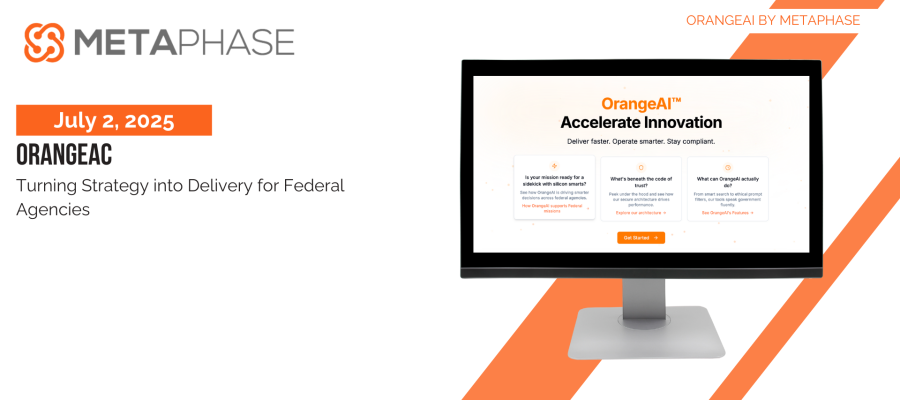
Federal agencies today face growing pressure to modernize while staying secure and compliant. At the same time, they must align evolving mission priorities with technical execution across increasingly complex systems. Too often, there is a disconnect between high-level goals set by leadership and the day-to-day work of agile development teams.
OrangeAC, a delivery accelerator developed by MetaPhase, addresses this challenge directly. It serves as a bridge between strategy and implementation by transforming agency objectives into clear, traceable work products. These include user stories, development epics, and behavior-driven acceptance criteria. The results are formatted to integrate seamlessly into tools like Jira and Azure DevOps, helping to convert conceptual planning into tested, auditable software.
This translation from strategy to delivery is essential. In many federal programs, requirements remain too abstract for effective execution. OrangeAC solves this by automating the generation of a structured development backlog. It enables agencies to move quickly without compromising traceability or governance.
The foundation of OrangeAC is built with federal security and compliance in mind. Because it is part of the broader OrangeAI suite, it inherits a secure architectural baseline. It integrates with OrangeATO to enforce access controls and align each work item with policies drawn from FedRAMP and NIST guidance. It supports secure deployment models, including controlled enclaves, and maintains auditable records of every action through built-in logging and tracking tools. The platform also supports automated validation of DevSecOps principles, ensuring that every story and criterion is aligned with agency compliance needs from the start.
What makes OrangeAC especially powerful is how it connects across the entire OrangeAI ecosystem. It feeds directly into OrangeTDD, which transforms its acceptance criteria into executable test cases. It provides structure to OrangeAPI and OrangeCI/CD, which use these stories to generate backend infrastructure and delivery pipelines. OrangeMELT connects observability and telemetry to the backlog, allowing teams to verify that systems meet expectations and remain mission-aligned over time.
With OrangeAC, agencies gain several critical benefits. It facilitates the rapid transformation of mission intent into manageable, testable work items. These items do not exist in isolation. Each one is tied to relevant testing, deployment, and monitoring components, minimizing gaps or manual rework. Because each story includes criteria written in plain language following behavior-driven syntax, teams can begin verification almost immediately. The tool also provides strong traceability, linking every change or feature directly back to its original requirement. Finally, OrangeAC supports cross-functional collaboration by giving product owners, security officers, and development teams shared visibility into the same delivery roadmap.
To better understand how OrangeAC might be applied, consider a few illustrative scenarios. In a secure identity modernization effort, a federal agency might define a strategic goal such as implementing single sign-on using Zero Trust architecture. OrangeAC would generate the related development stories, compliance checks, and test coverage needed to support this effort within the agency's delivery pipeline. In a citizen engagement project, an agency may wish to improve the experience of uploading documents through a public portal. OrangeAC would produce the stories, backend service updates, security protocols, and monitoring criteria aligned with that goal. In another case, when NIST control updates require system changes, OrangeAC can generate a focused backlog to support remediation, including updated access controls, infrastructure changes, and policy documentation. These are hypothetical examples, and actual implementations would depend on the agency's mission, technical environment, and governance structure.
Ultimately, OrangeAC represents a new approach to agile delivery in the federal space. Rather than treating compliance as an afterthought or separating strategy from execution, it integrates them from the beginning. It makes it possible for agencies to move faster, stay secure, and maintain visibility from planning to production. When paired with the other modules in the OrangeAI suite, OrangeAC enables a delivery ecosystem that is not only responsive to mission needs but built to operate within the complex policy and technical environments that define the federal government.
For agency leaders focused on driving outcomes with confidence, OrangeAC offers a practical, secure, and accountable way to get there.
To discover more about the OrangeAI suite of tools, visit https://orangeai.metaphase.tech/

